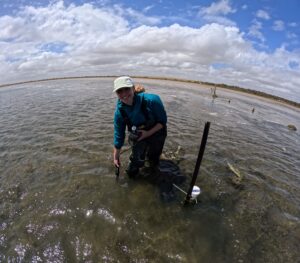Spencer Gulf is a key asset of South Australia. In addition to being home to important marine ecosystems and protected animal species, aquaculture, marine and ecotourism industries in the region have been valued at over AU$500 million per year. The region is also a major gateway to the state’s energy, mining and agricultural resources.
The Goyder Institute for Water Research’s project Socio-ecological assessment of the ecosystems, industries and communities of Spencer Gulf is now nearing completion. By providing Spencer Gulf communities and stakeholders with diverse, integrated economic, social and ecological information, the project will help facilitate decision-making that is evidence-based and which takes into account economic imperatives but also ecological, environmental and social factors. Two reports containing the latest developments have been published, with a snapshot of the socio-ecological status of Spencer Gulf to be made available in the near future.
The Socio-ecological assessment of the ecosystems, industries and communities of Spencer Gulf project is funded by the Goyder Institute, the Fisheries Research and Development Corporation (FRDC) and the Spencer Gulf Ecosystem and Development Initiative (SGEDI). It’s led by Associate Professor Tim Ward from South Australian Research and Development Institute (SARDI), a division of Primary Industries and Regions SA (PIRSA). The project is being undertaken in collaboration with the University of Adelaide, Flinders University, and the Department for Environment and Water.
Through the project, a time-series of around 170 ecological, economic and social indicators for the Spencer Gulf were developed. Information vital for informed decision-making capability is now available in one place rather than being segregated into different sectors and organisations. These include climate indices (for example, El Niño conditions), weather patterns, sea level height, temperature and salinity, plus ecological features such as cuttlefish, Australian sealion, long-nosed fur seals and seagrass. Data is also available on pollution, marine industries, fisheries, aquaculture, ecotourism and shipping, as well as numbers describing community and human activities. Gaps in information have also been identified to inform future monitoring.
In addition to the time-series data, spatial information in the Spencer Gulf project has been advanced through the project. Maps of environmental characteristics, ecological assets, human activities, management arrangements and socio-economic values are now available. A fully functioning prototype of software platform Gulfview exists, with new scientific assessments incorporated, data sets trialled and a user guide generated.
Gulfview is an integrated Spencer Gulf management tool. It aggregates different kinds of spatially-explicit information to help industries, communities and decision-makers conduct evidence-based evaluations of proposed Spencer Gulf developments. The user-guide for the software contains three case studies which show how Gulfview can be applied to identify areas with key characteristics of interest: for example, marine environments that might be suitable for finfish aquaculture farms, regions for potential seawater desalination plants and areas that need protection due to ecological significance. The platform and spatial data will be available through the PIRSA-SARDI website.
The project has furthered South Australia’s transition to the globally-established approach called Integrated Ecosystem Assessment (IEA). IEA is a way to fill gaps in knowledge while engaging relevant stakeholders and policy-makers, and maintaining community well-being.
Applying IEA for effective management of oceanic resources is consistent with key actions in Australia’s National Marine Science Plan, which is currently being refreshed. Spencer Gulf is one of four national IEA case studies selected for this national update. A successful international IEA example is the California Current Integrated Ecosystem Assessment (CCIEA). The CCIEA is one of five regional IEAs undertaken by the United States of America’s National Oceanic and Atmospheric Administration (NOAA).
The Spencer Gulf time series and spatial data, and the application of the IEA approach in the project work has been shared with SA government agencies and stakeholders and will be presented to other key agencies in the near future.
Contact Professor Tim Ward for more information about the project and to discuss availability of the Gulfview platform.
The reports referred to in this article are:
Socio-ecological assessment of the ecosystems, industries and communities of Spencer Gulf: ‘Gulfview’ interactive platform by Frédéric Bailleul, Tim M. Ward
Potential social, economic and ecological indicators for integrated ecosystem assessment of Spencer Gulf by Jason E. Tanner, Fred Bailleul, Simon Bryars, Mark Doubell, Nicole Foster, Sam Gaylard, Bronwyn M. Gillanders, Simon Goldsworthy, Charlie Huveneers, Charles James, Alice R. Jones, Jacob Maher, Melissa Nursey-Bray, Paul van Ruth and Tim M. Ward


